instrument panel CHEVROLET CAVALIER 1996 3.G Owners Manual
[x] Cancel search | Manufacturer: CHEVROLET, Model Year: 1996, Model line: CAVALIER, Model: CHEVROLET CAVALIER 1996 3.GPages: 372, PDF Size: 19.73 MB
Page 19 of 372
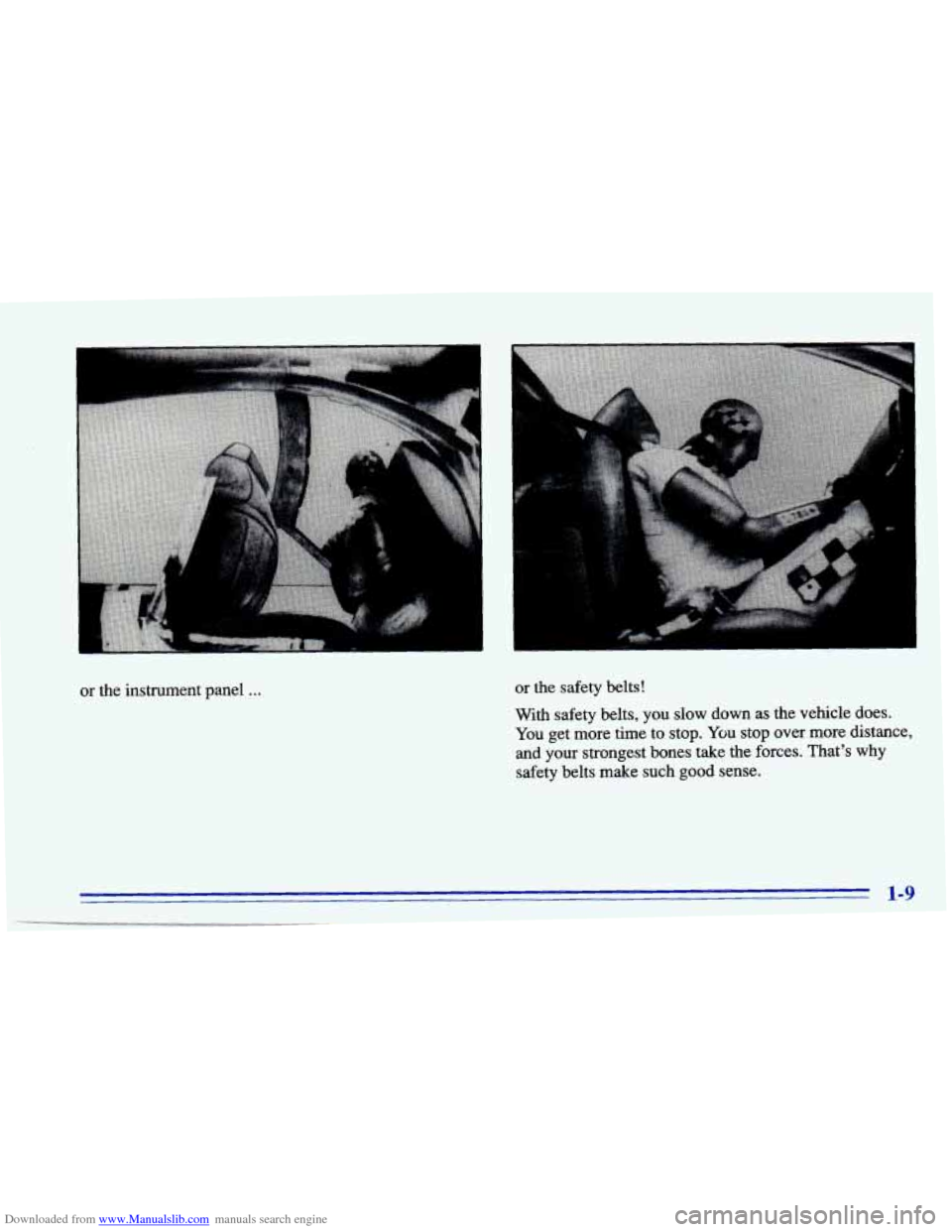
Downloaded from www.Manualslib.com manuals search engine I
or the instrument panel ...
I
or the safety belts!
Wia safety belts, you slow down as the vehicle does.
You get more time to stop. You stop over more distance,
and your strongest bones take the forces. That's why
safety belts make such good sense.
1-9
Page 30 of 372
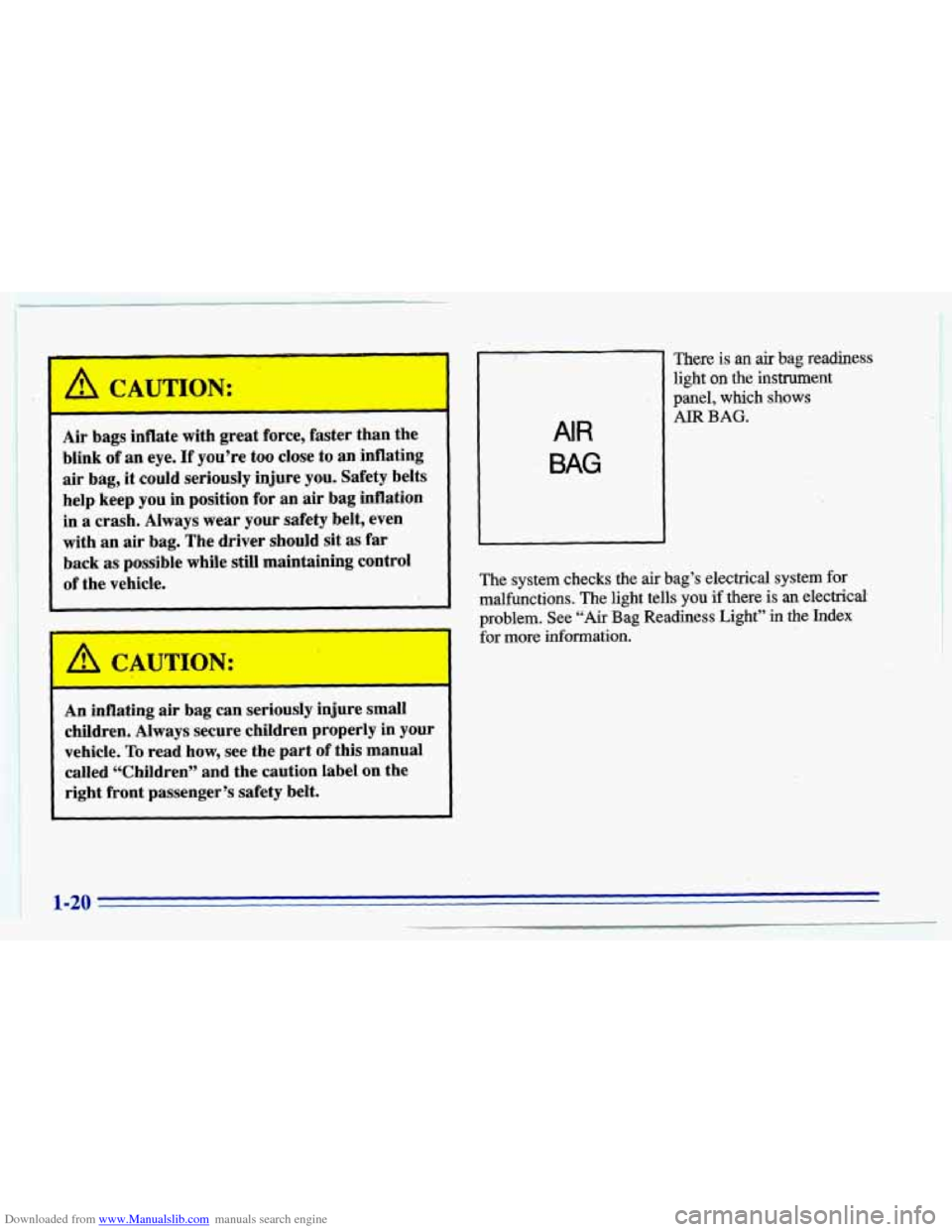
Downloaded from www.Manualslib.com manuals search engine I
A CAUTION:
Air bags inflate with great force, faster than the
blink
of an eye. If you’re too close to an inflating
air bag, it could seriously injure you. Safety belts
help keep you in position for an
air bag inflation
in
a crash. Always wear your safety belt, even
with an air
bag. The driver should sit as far
back as possible while still maintaining control
of the vehicle.
A CAUTION:
R -
An inflating air bag can seriously injure small
children. Always secure children properly in your
vehicle.
To read how, see the part of this manual
called “Children” and the caution label
on the
right front passenger’s safety belt.
AIR
BAG
There is an air bag readiness
light on the instrument
panel, which shows
AIR BAG.
The system checks the air bag’s electrical system for
malfunctions. The light tells you if there is an electrical
problem. See
“Air Bag Readiness Light” in the Index
for more information.
1-20
Page 31 of 372
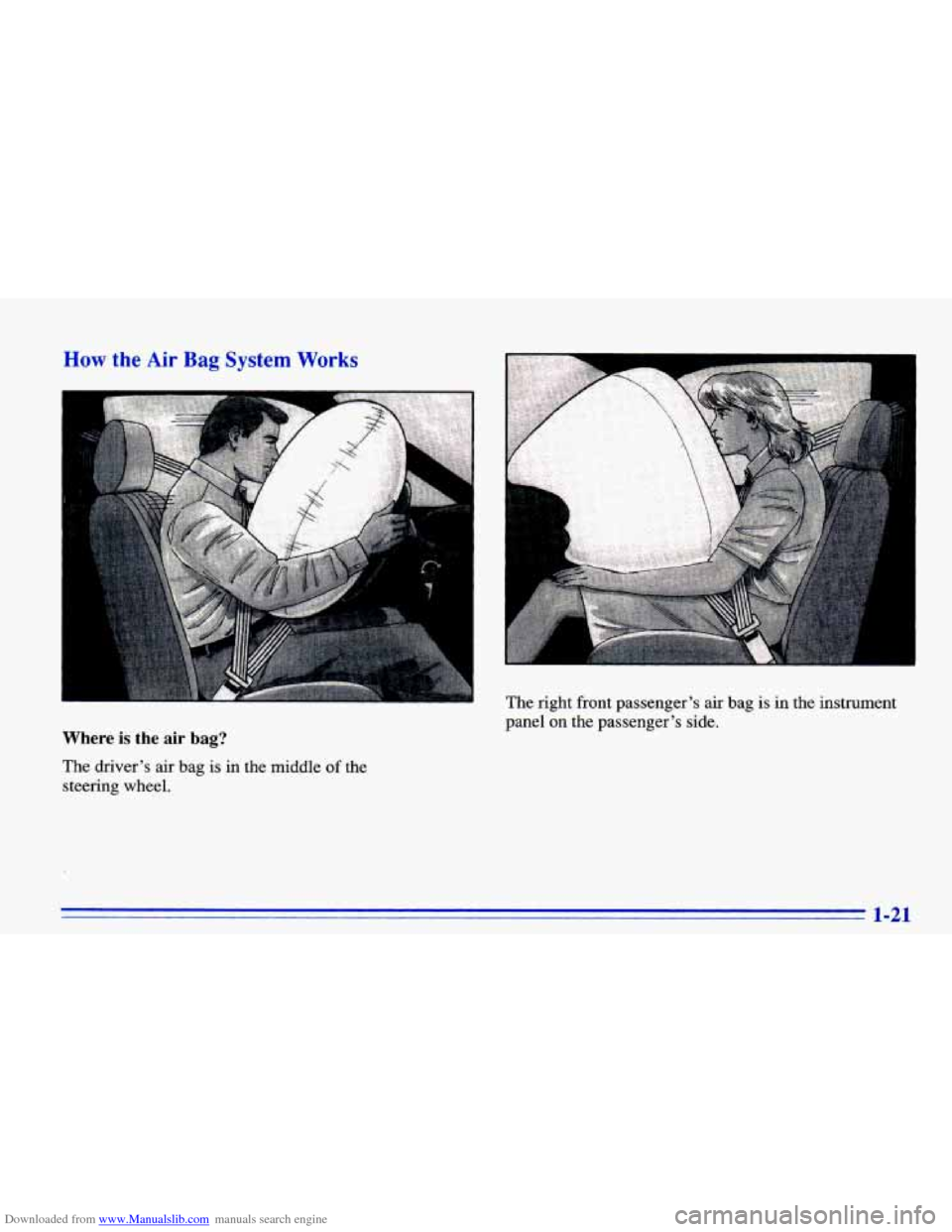
Downloaded from www.Manualslib.com manuals search engine How the Air Bag System Works
Where is the air bag?
..
The right front passenger's air bag is in the instrument
panel
on the passenger's side.
The driver's air bag
is in the middle of the
steering wheel.
Page 32 of 372
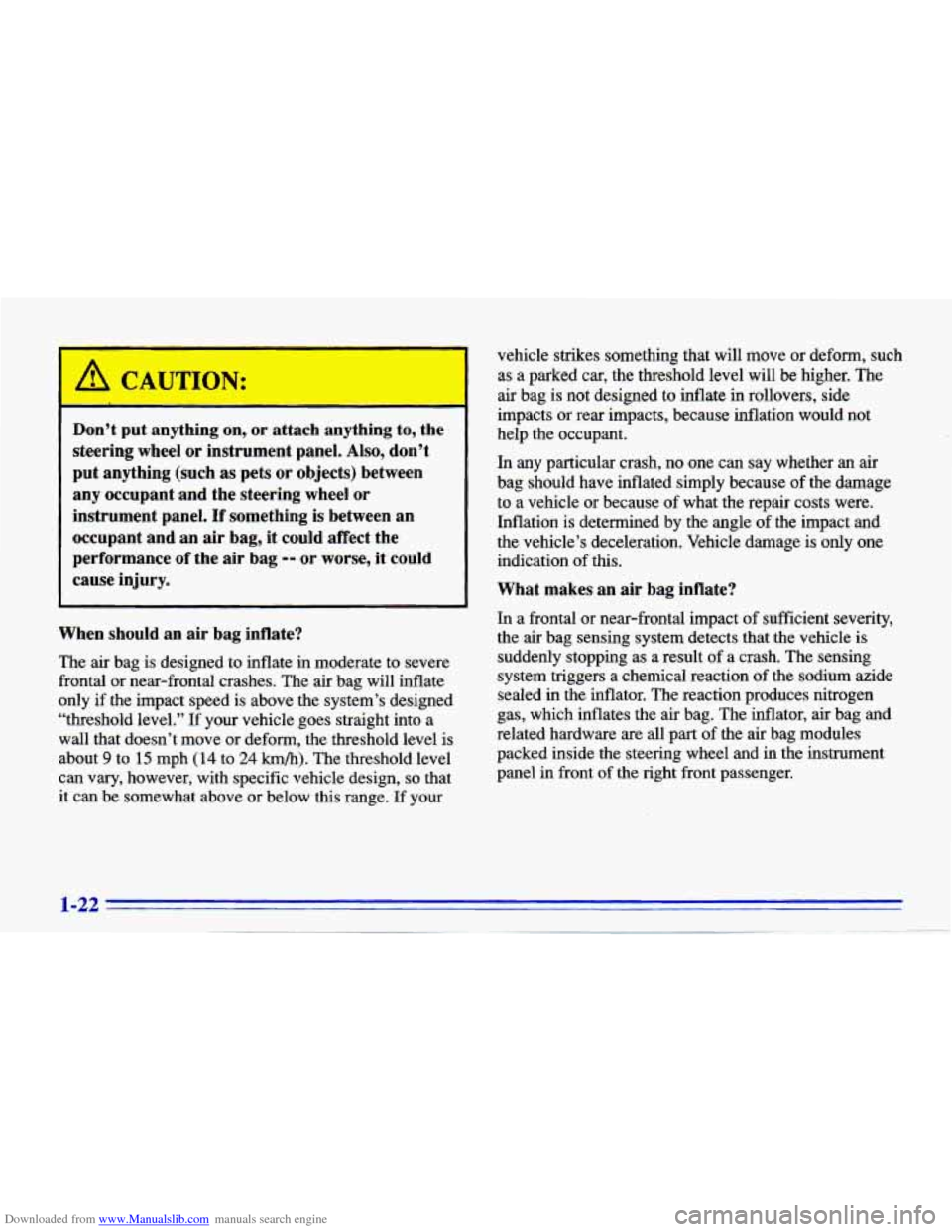
Downloaded from www.Manualslib.com manuals search engine I,
-
Don’t put anything on, or attach anything to, the steering wheel or instrument panel. Also, don’t
put anything (such as pets or objects) between
any occupant and the steering wheel or
instrument panel.
If something is between an
occupant and an air bag, it could affect the
performance
of the air bag -- or worse, it could
cause injury.
When should an air bag inflate?
The air bag is designed to inflate in moderate to severe
frontal or near-frontal crashes. The air bag will inflate
only if the impact speed is above the system’s designed
“threshold level.”
If your vehicle goes straight into a
wall that doesn’t move or deform, the threshold level is
about
9 to 15 mph (14 to 24 krn/h). The threshold level
can vary, however, with specific vehicle design,
so that
it can be somewhat above
or below this range. If your vehicle strikes
something that will move or deform, such
as a parked car, the threshold level will be higher. The
air bag is not designed to inflate
in rollovers, side
impacts or rear impacts, because inflation would not
help
the occupant.
In
any particular crash, no one can say whether an air
bag should have inflated simply because of the damage
to a vehicle
or because of what the repair costs were.
Inflation is determined by the angle of the impact and
the vehicle’s deceleration. Vehicle damage is only one
indication of this.
What makes an air bag inflate?
In a frontal or near-frontal impact of sufficient severity,
the air bag sensing system detects that the vehicle is
suddenly stopping as a result of a crash. The sensing
system triggers a chemical reaction of the sodium azide
sealed in the inflator. The reaction produces nitrogen
gas, which inflates the air bag. The inflator, air
bag and
related hardware are all part of the
air bag modules
packed inside the steering wheel and in the instrument
panel in front
of the right front passenger.
Page 33 of 372
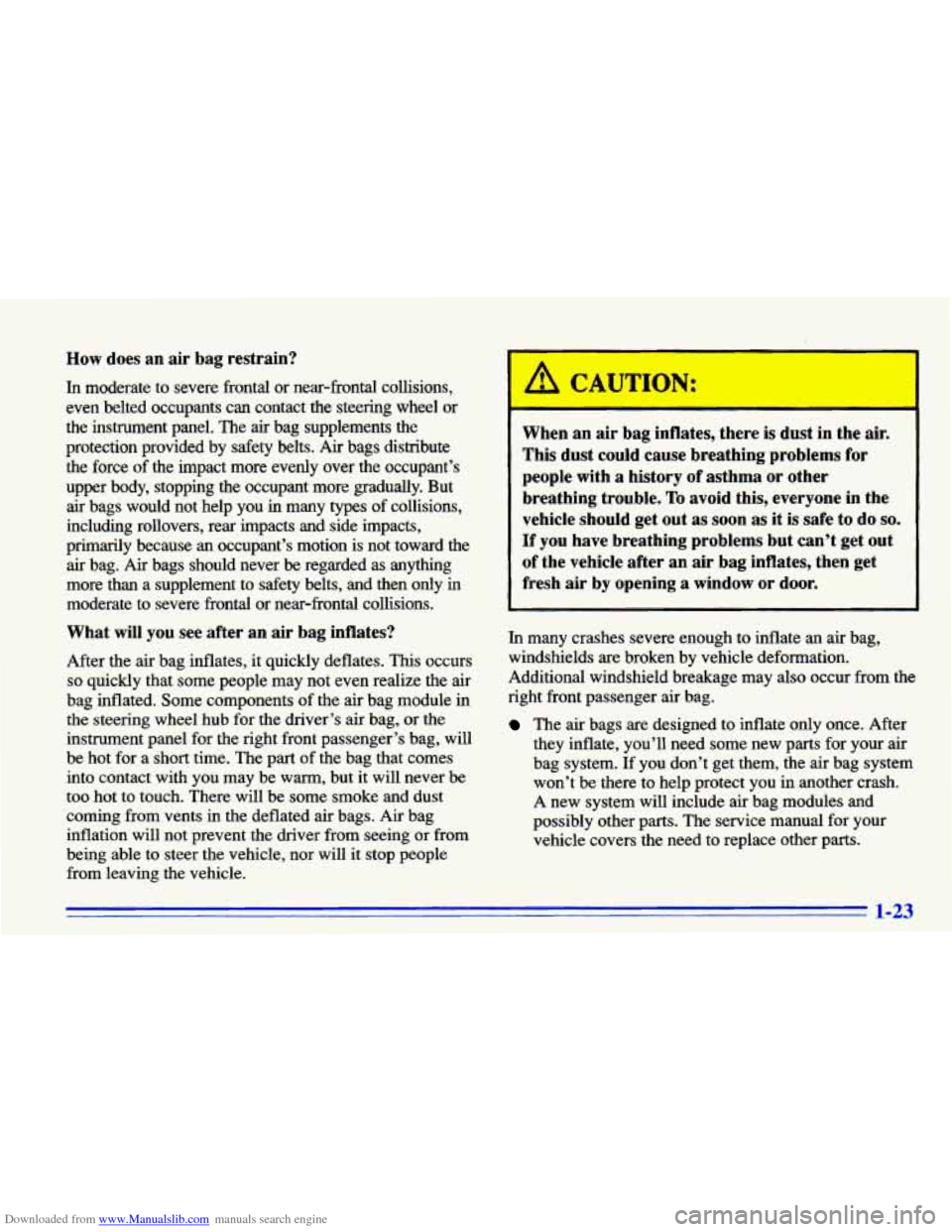
Downloaded from www.Manualslib.com manuals search engine How does an air bag restrain?
In moderate to severe frontal or near-frontal collisions,
even belted occupants can contact the steering wheel or
the instrument panel. The
air bag supplements the
protection provided by
safety belts. Air bags distribute
the
force of the impact more evenly over the occupant’s
upper body, stopping the occupant more gradually. But
air bags would not help you in many types of collisions,
including rollovers, rear impacts and side impacts,
primarily because an occupant’s motion is not toward the
air bag. Air bags should never be regarded as anythmg
more than a supplement to safety belts, and then only in
moderate
to severe frontal or near-frontal collisions.
What will you see after an air bag inflates?
After the air bag inflates, it quickly deflates. This occurs
so quickly that some people may not even realize the air
bag inflated. Some components of the air bag module in
the steering wheel hub for the driver’s air bag, or the
instrument panel for the right front passenger’s bag, will
be hot for a short time. The part
of the bag that comes
into contact with you may be warm, but it will never be
too hot to touch. There will be some smoke and dust
coming from vents in the deflated air bags. Air bag
inflation will not prevent the driver from seeing or from
being able to steer the vehicle, nor will
it stop people
from leaving the vehicle.
I
When an air bag inflates, there is dust in the air.
This dust could cause breathing problems for
people with a history
of asthma.or other
breathing trouble.
To avoid this, everyone in the
vehicle should get out as soon as
it is safe to do so.
If you have breathing problems but can’t get out
of the vehicle after an air bag inflates, then get
fresh air by opening
a window or door.
In many crashes severe enough to inflate an air bag,
windshields are broken by vehicle deformation.
Additional windshield breakage may also occur from the
right front passenger air bag.
The air bags are designed to inflate only once. After
they inflate, you’ll need some new parts for your
air
bag system. If you don’t get them, the air bag system
won’t be there to help protect you in another crash.
A new system will include air bag modules and
possibly other parts. The service manual for your
vehicle covers the need to replace other parts.
1-23
Page 34 of 372
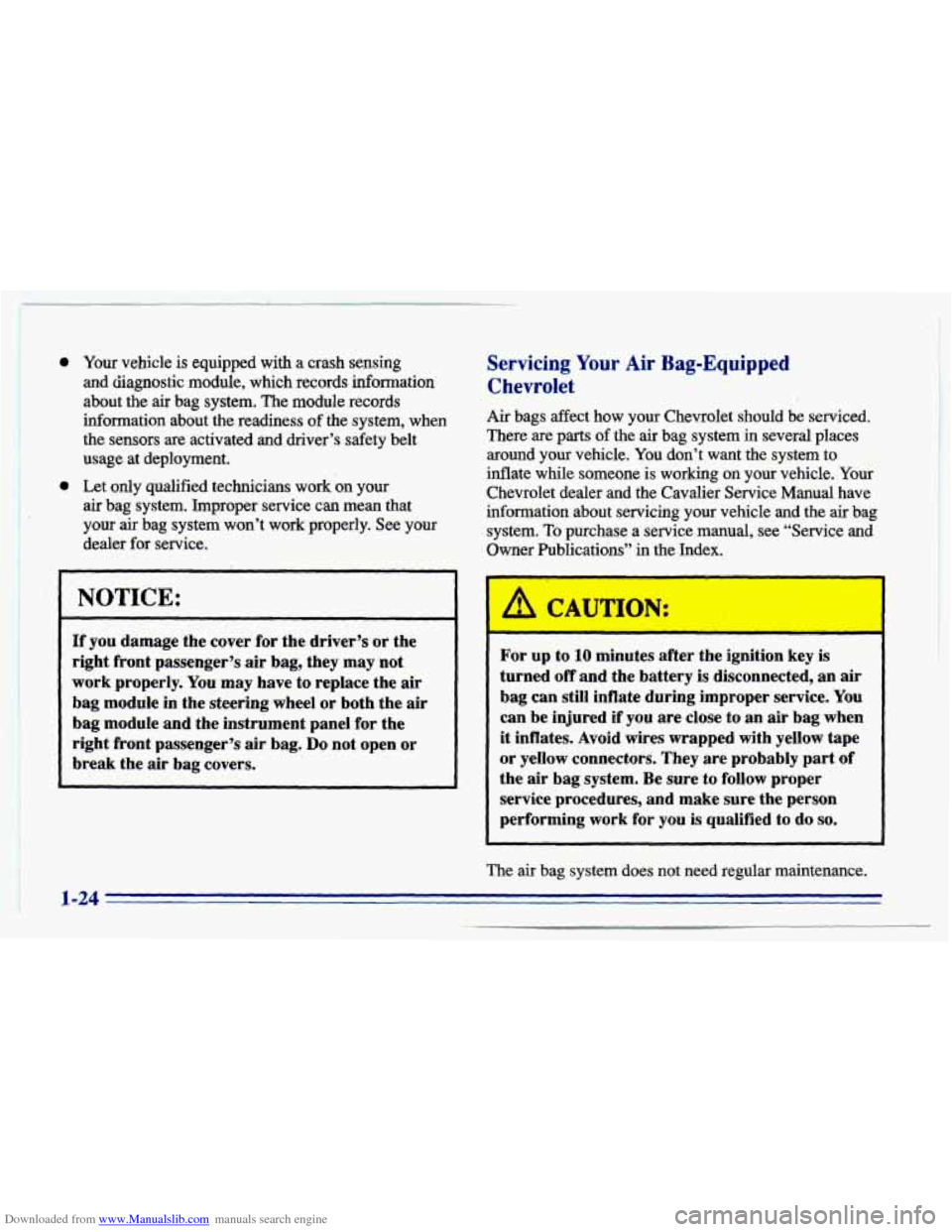
Downloaded from www.Manualslib.com manuals search engine 0
,e
Your vehicle is equipped with a crash sensing
and diagnostic module, which records information
about the
air bag system. The module records
information about the readiness
of the system, when
the sensors are activated and driver’s safety belt
usage at deployment.
Let
only qualified technicians work on your
air bag system. Improper service can mean that
your
air bag system won’t work properly. See your
dealer for service.
Servicing Your Air Bag-Equipped
Chevrolet
Air bags affect how your Chevrolet should be serviced.
There are
parts of the air bag system in several places
around your vehicle. You don’t want
the system to
inflate while someone is working
on your vehicle. Your
Chevrolet dealer and the Cavalier Service Manual have
information about servicing your vehicle and
the air bag
system.
To purchase a service manual, see “Service and
Owner Publications”
in the Index.
NOTICE:
If you damage the cover for the’ driver’s or the
right front passenger’s
air bag, they may not
work properly. You may have to replace the
air
bag module in the steering wheel or both the air
bag module and the instrument panel for the
right front passenger’s
air bag. Do not open or
break the
air bag covers.
I
For up to 10 minutes after the ignition key is
turned off and the battery is disconnected, an air
bag can still inflate during improper service. You
can be injured
if you are close to an air bag when
it inflates. Avoid wires wrapped with yellow tape
or yellow connectors. They are probably part of
the
air bag system. Be sure to follow proper
service procedures, and make sure the person
performing work for you
is qualified to do so.
The air bag system does not need regular maintenance.
Page 59 of 372
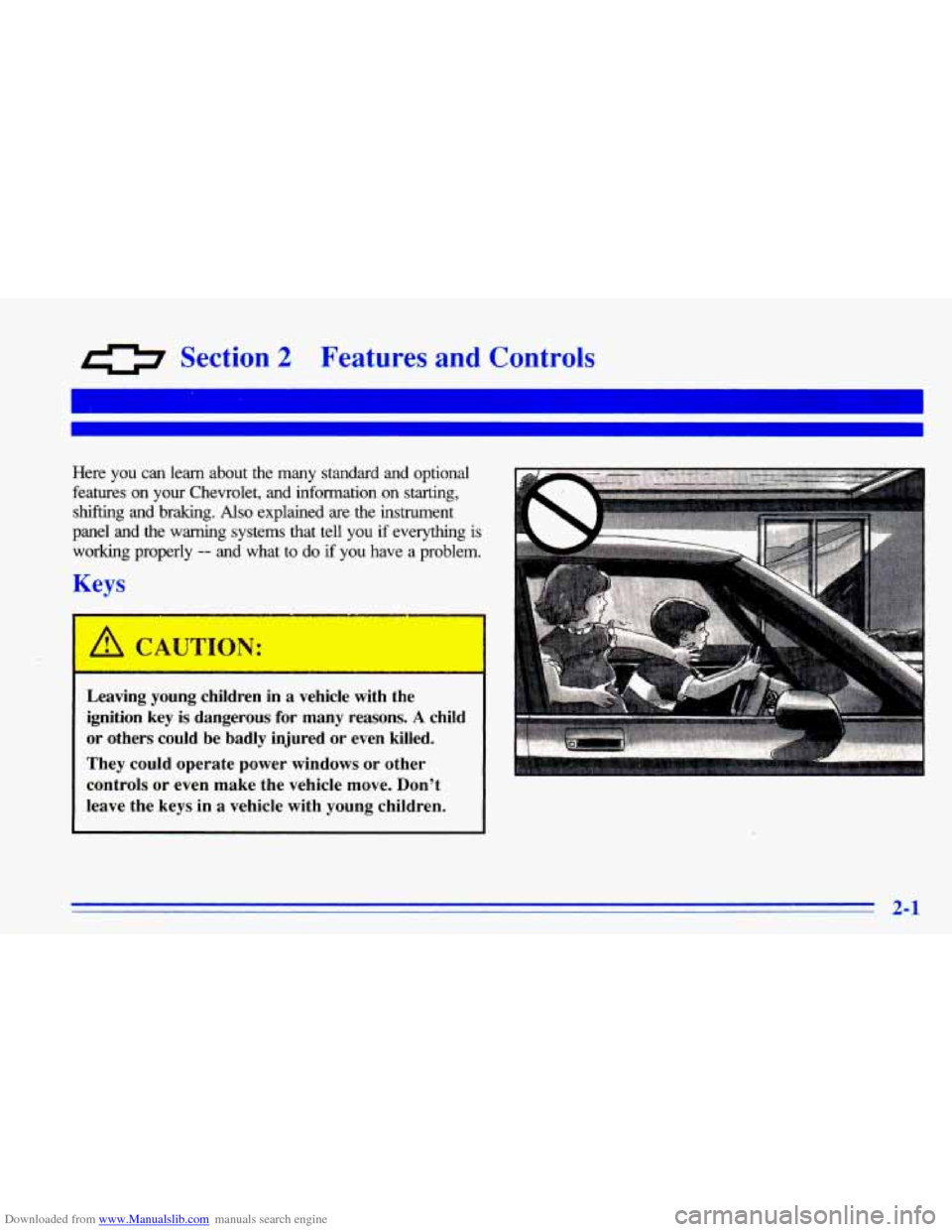
Downloaded from www.Manualslib.com manuals search engine a Section 2 Features and Controls
Here you can learn about the many standard and optional
features on your Chevrolet, and information on starting,
shifting and braking.
Also explained are the instrument
panel and the
warning systems that tell you if everythmg is
working properly -- and what to do if you have a problem.
Keys
*.
I A CAUTION: - .-
Leaving young children in a vehicle with the
ignition key is dangerous for many reasons.
A child
or others could be badly injured
or even killed.
They could operate power windows or other
controls
or even make the vehicle move. Don’t
leave the
keys in a vehicle with young children.
2-1
Page 65 of 372
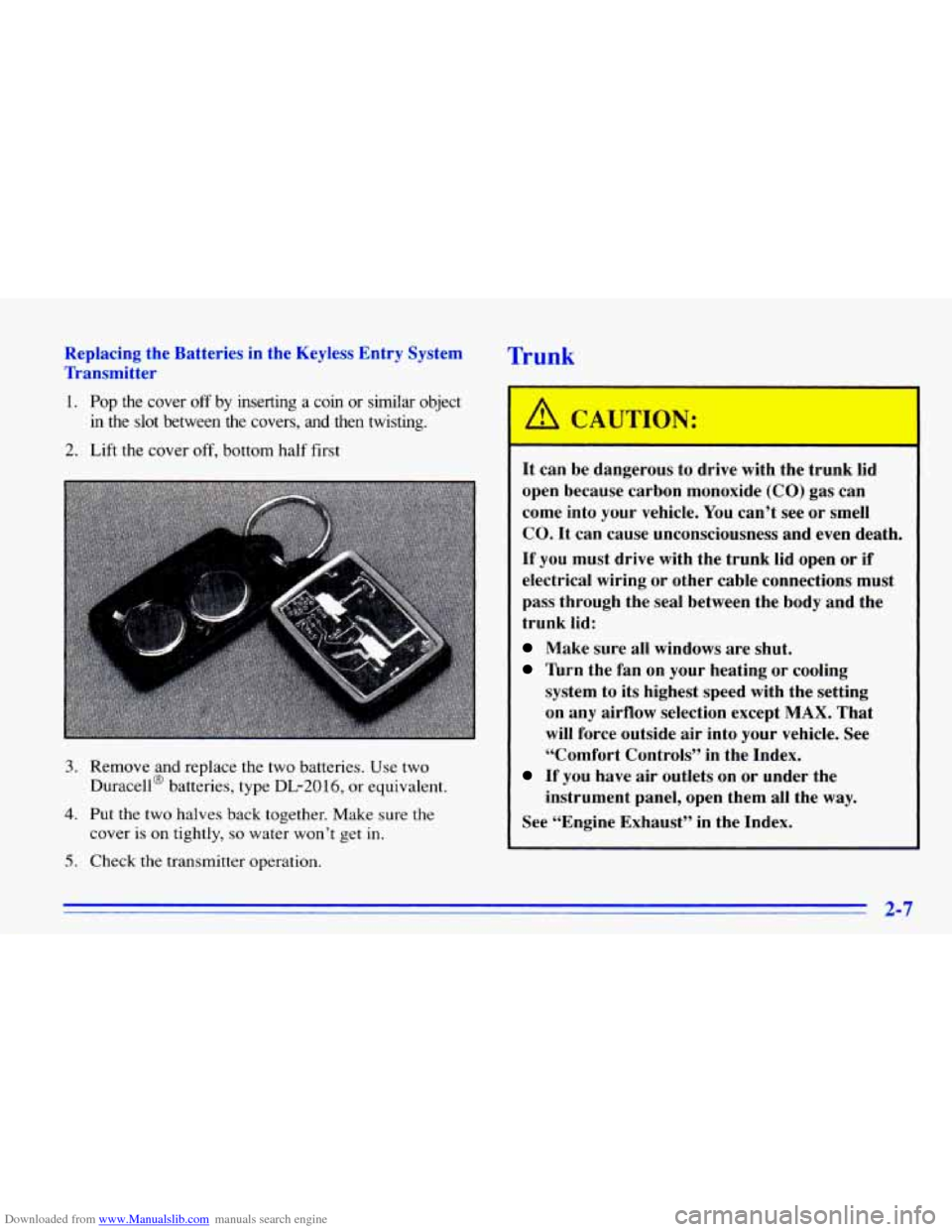
Downloaded from www.Manualslib.com manuals search engine Replacing the Batteries in the Keyless Entry System
Transmitter
1. Pop the cover off by inserting a coin or similar object
in the slot between the covers,
and then twisting.
2. Lift the cover off, bottom half first
3. Remove and replace the two batteries. Use two
Duracell@ batteries, type
DL-2016, or equivalent.
4. Put the two halves back together. Make sure the
cover
is on tightly, so water won’t get in.
5. Check the transmitter operation.
Trunk
It can be dangerous to drive with the trunk lid
open because carbon monoxide (CO) gas can
come into your vehicle. You can’t see or smell
CO. It can cause unconsciousness and even death.
If you must drive with the trunk lid open or if
electrical wiring or other cable connections must
pass through the seal between the body and the
trunk
lid:
Make sure all windows are shut.
Turn the fan on your heating or cooling
system to its highest speed with the setting
on any airflow selection except
MAX. That
will force outside air into your vehicle. See
“Comfort Controls” in the Index.
If you have air outlets on or under the
instrument panel, open them
all the way.
See “Engine Exhaust” in the Index.
2-7
Page 68 of 372
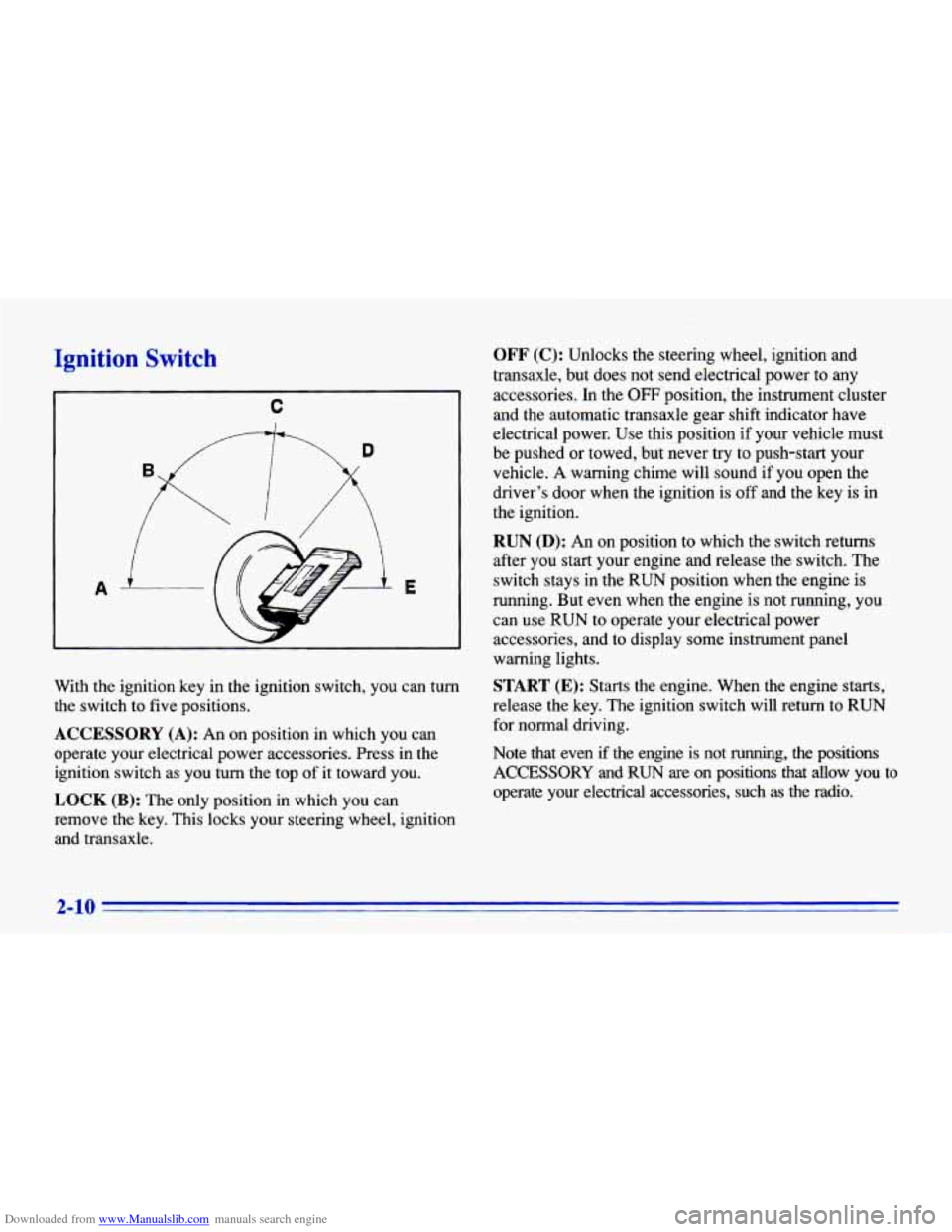
Downloaded from www.Manualslib.com manuals search engine Ignition Switch
A E
With the ignition key in the ignition switch, you can turn
the switch to five positions.
ACCESSORY (A): An on position in which you can
operate your electrical power accessories. Press in the
ignition switch as you turn the top of it toward you.
LOCK (B): The only position in which you can
remove the key. This locks your steering wheel, ignition
and transaxle.
OFF (C): Unlocks the steering wheel, ignition and
transaxle, but does not send electrical power to any
accessories.
In the OFF position, the instrument cluster
and the automatic transaxle gear shift indicator have
electrical power. Use this position if your vehicle must
be pushed or towed, but never try to push-start your
vehicle.
A warning chime will sound if you open the
driver’s door when the ignition is
off and the key is in
the ignition.
RUN (D): An on position to which the switch returns
after you start your engine and release the switch. The
switch stays in the RUN position when the engine is
running. But even when the engine is not running, you can use RUN to operate your electrical power
accessories, and to display some instrument panel
warning lights.
START (E): Starts the engine. When the engine starts,
release the key. The ignition switch will return to RUN
for normal driving.
Note that even if the engine is not running, the positions
ACCESSORY and RUN are on positions that allow you to
operate your electrical accessories, such
as the radio.
2-10
Page 70 of 372
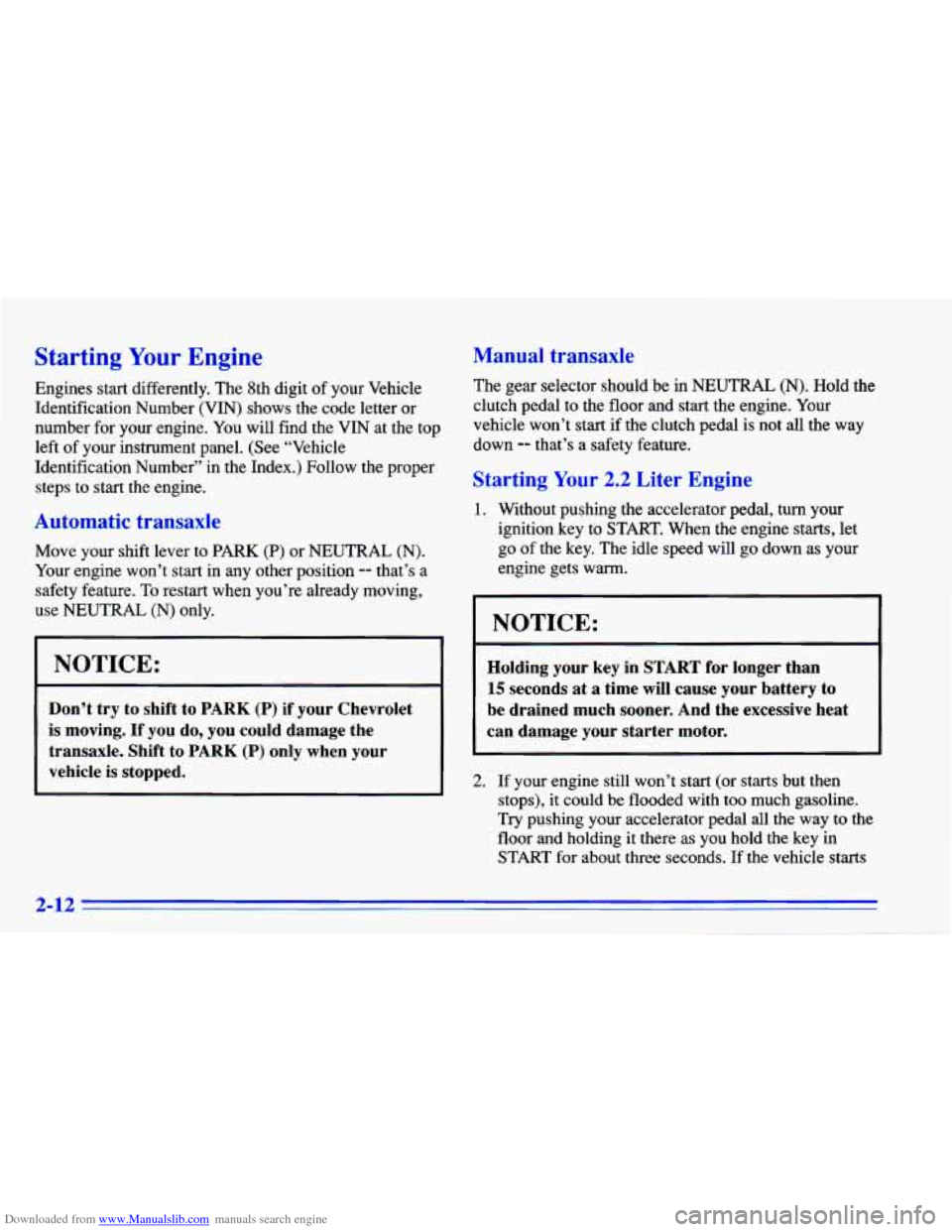
Downloaded from www.Manualslib.com manuals search engine Starting Your Engine
Engines start differently. The 8th digit of your Vehicle
Identification Number (VIN) shows the code letter or
number for your engine. You will find the VIN at the top
left of your instrument panel. (See “Vehicle
Identification Number” in the Index.) Follow the proper
steps to start the engine.
Automatic transaxle
Move your shift lever to PARK (P) or NEUTRAL (N).
Your engine won’t start in any other position -- that’s a
safety feature.
To restart when you’re already moving,
use
NEUTRAL (N) only.
NOTICE:
Don’t try to shift to PARK (P) if your Chevrolet
is moving.
If you do, you could damage the
transaxle. Shift to PARK
(P) only when your
vehicle is stopped.
Manual transaxle
The gear selector should be in NEUTRAL (N). Hold the
clutch pedal to the floor and start the engine. Your
vehicle won’t start if the clutch pedal is not all
the way
down
-- that’s a safety feature.
Starting Your 2.2 Liter Engine
1. Without pushing the accelerator pedal, turn your
ignition key to START. When the engine starts, let
go
of the key. The idle speed will go down as your
engine gets warm.
I NOTICE:
r
Holding your key in START for longer than
15 seconds at a time will cause your battery to
be drained much sooner. And the excessive heat
can damage your starter motor.
2. If your engine still won’t start (or starts but then
stops), it could be flooded with too much gasoline.
Try pushing your accelerator pedal all the way to the
floor and holding it there as you hold
the key in
START for about three seconds. If the vehicle starts
2-12